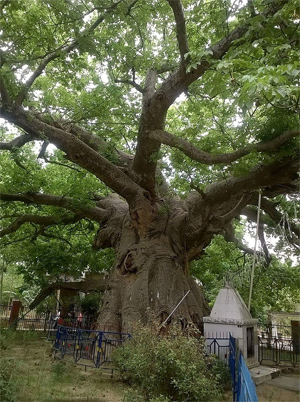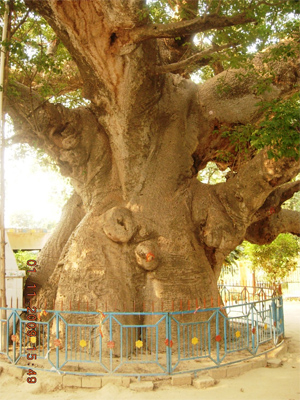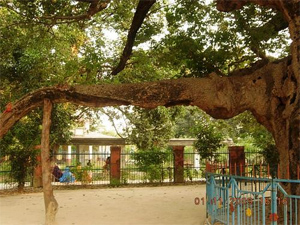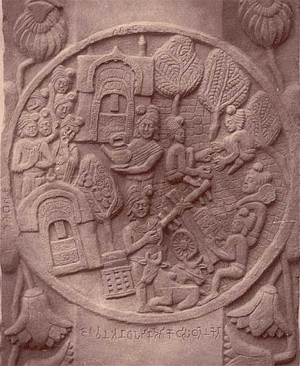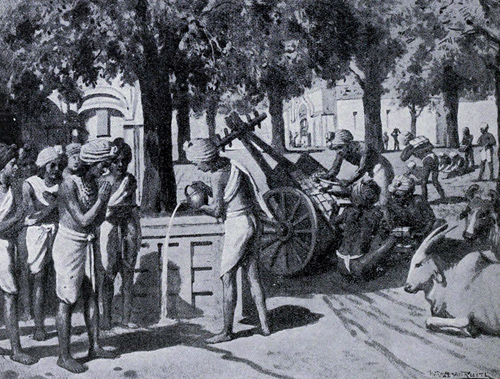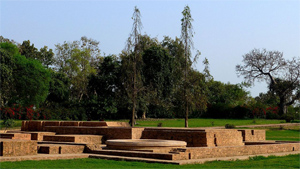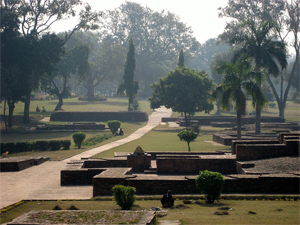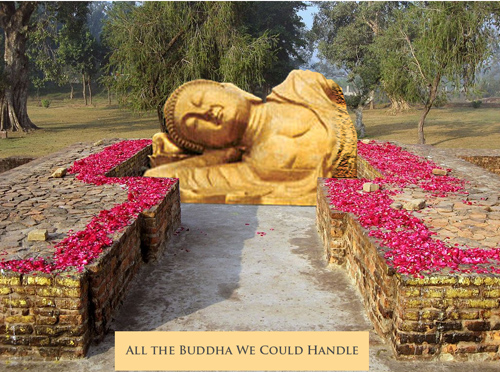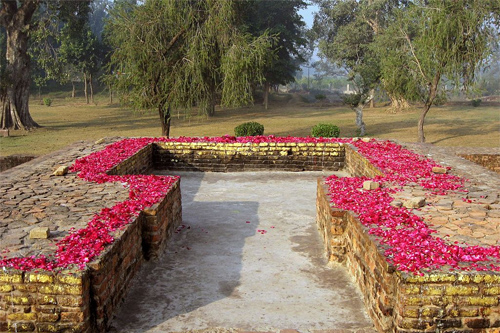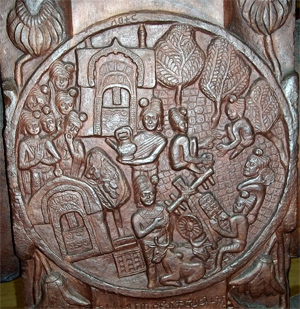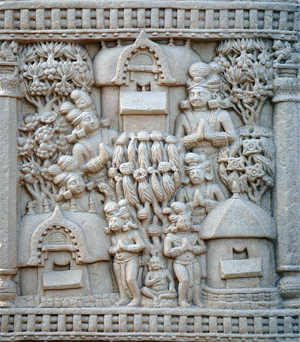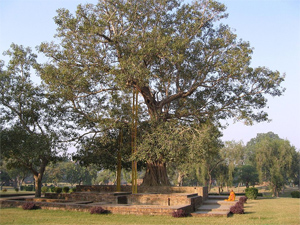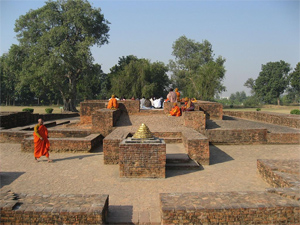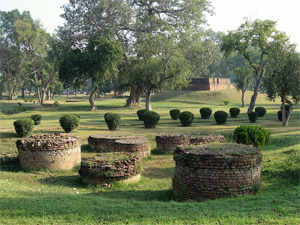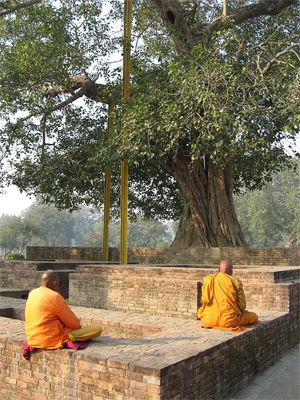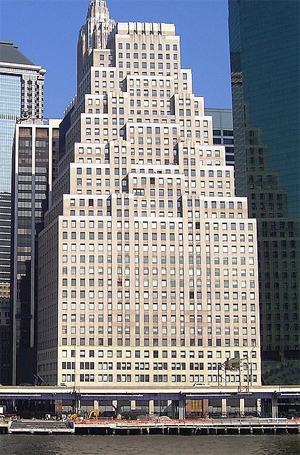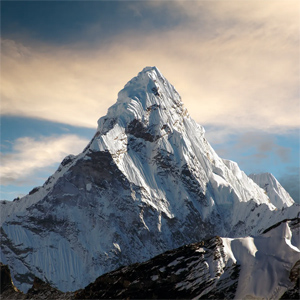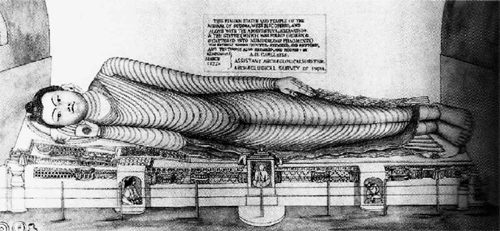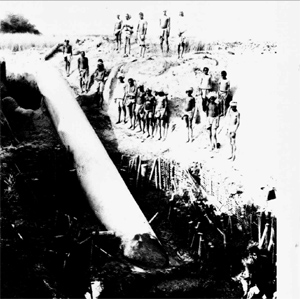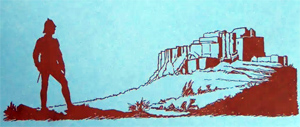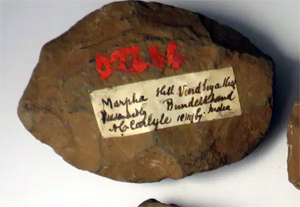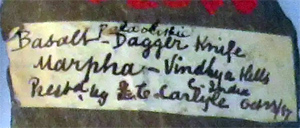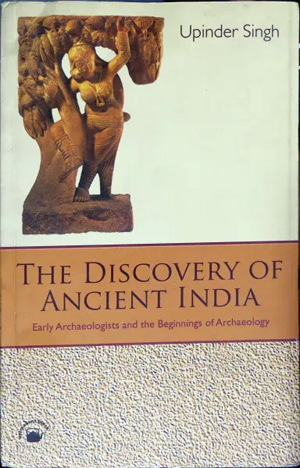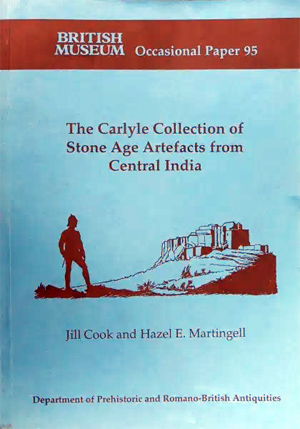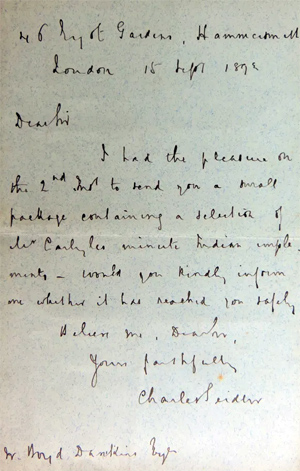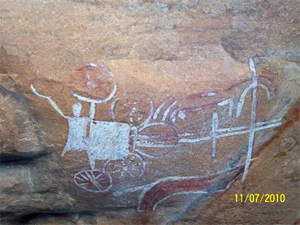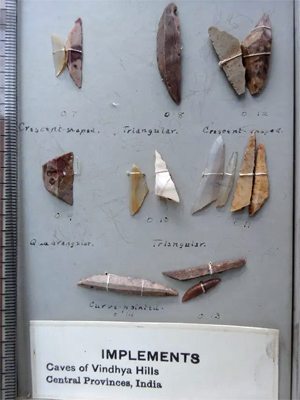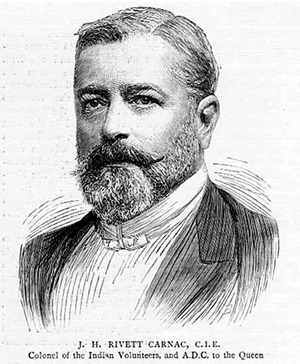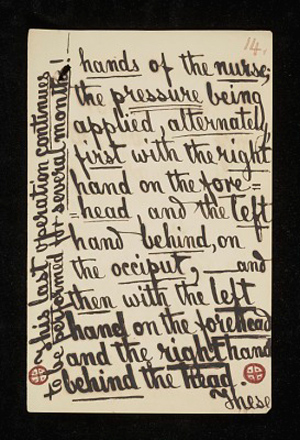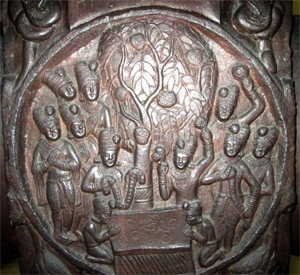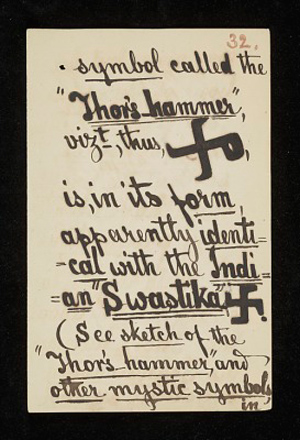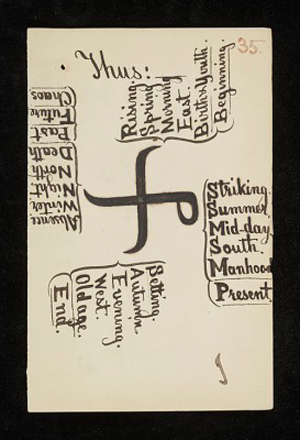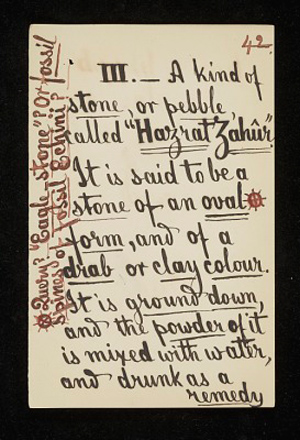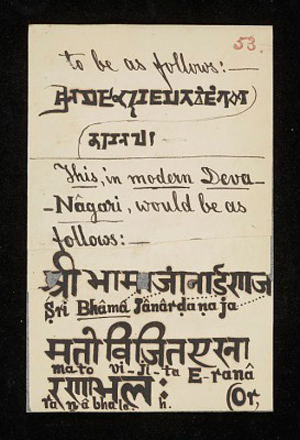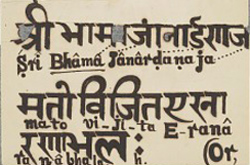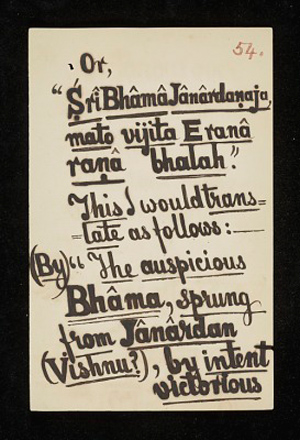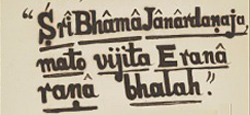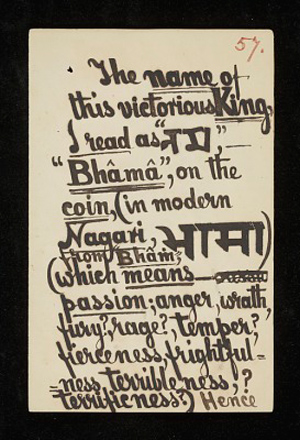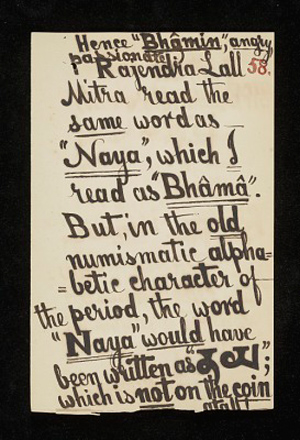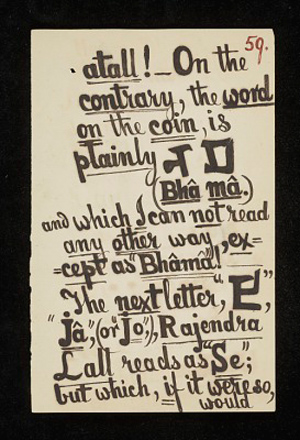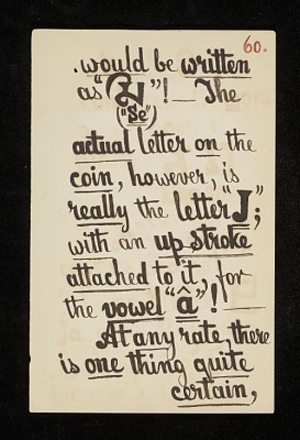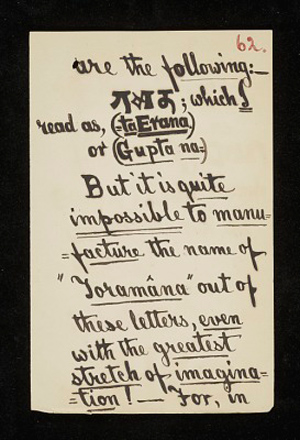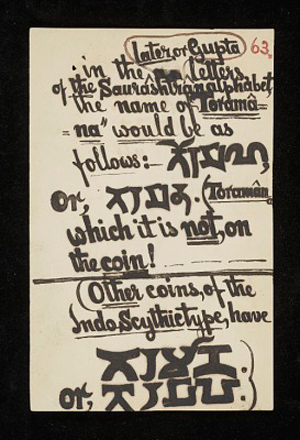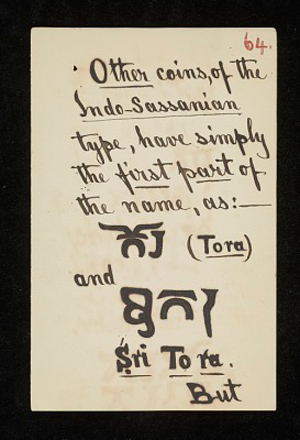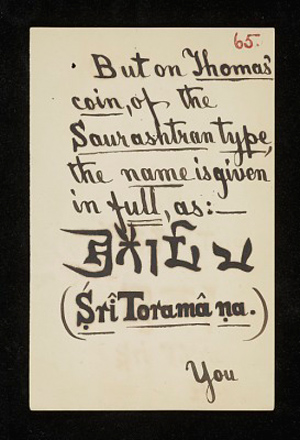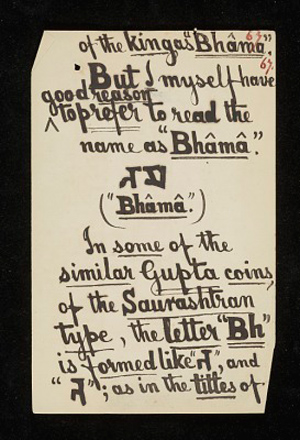by Wikipedia
Accessed: 3/14/21
For the title for the divider of Vedas, see Vyasa (title). For the crater on Mercury, see Vyasa (crater). For the Brahmin community often pronounced as Vyas, see Bias Brahmin. For other uses, see Vyasa (disambiguation).
To what purpose, it may be asked, have we ascertained the age of Munis? Who was Parasara? Who was Garga? With whom were they contemporary, or with whose age may theirs be compared? What light will these inquires throw on the history of India or of mankind? I am happy in being able to answer those questions with confidence and precision.
All the Brahmens agree, that only one Parasara is named in their sacred records; that he composed the astronomical book before cited, and a law-tract, which is now in my possession; that he was the grandson of Vasishtha, another astronomer and legislator, whose works are still extent, and who was the preceptor of Rama, King of Ayodhya; that he was the father of Vyasa, by whom the Vedas were arranged in the form which they now bear, and whom Crishna himself names with exalted praise in the Gita; so that, by the admission of the Pandits themselves, we find only three generations between two of the Ramas, whom they consider as incarnate portons of the divinity; and Parasara might have lived till the beginning of the Caliyuga, which the mistaken doctrine of an oscillation in the cardinal points has compelled the Hindus to place 1920 years too early. This error, added to their fanciful arrangement of the four ages, has been the source of many absurdities; for they insist that Valmic, whom they cannot but allow to have been contemporary with Ramachandra, lived in the age of Vyasa who consulted him on the composition of the Mahabharat, and who was personally known to Balarama, the brother of Crishna. When a very learned Brahmen had repeated to me an agreeable story of a conversation between Valmic and Vyasa, I expressed my surprize at an interview between two bards, whose ages were separated by a period of 864,000 years; but he soon reconciled himself to so monstrous an anachronism, by observing that the longevity of the Munis was preternatural, and that no limit could be set to divine power. By the same recourse to miracles or to prophesy, he would have answered another objection equally fatal to his chronological system. It is agreed by all, that the lawyer Yagyawalcya was an attendant on the court of Janaca, whose daughter Sita was the constant but unfortunate wife of the great Rama, the hero of Valmic's poem; but that lawyer himself, at the very opening of his work, which now lies before me, names both Parasara and Vyasa among twenty authors, whose tracts form the body of original Indian law. By the way, since Vasishtha is more that once named in the Manavisahhita, we may be certain that the laws ascribed to Menu, in whatever age they might have been first promulgated, could not have received the form in which we now see them, above three thousand years ago. The age and functions of Garga lead to consequences yet more interesting: he was confessedly the purohita, or officiating priest, of Crishna himself, who, when only a herdsman’s boy at Mathura, revealed his divine character to Garga, by running to him with more than mortal benignity on his countenance, when the priest had invoked Narayan. His daughter was eminent for her piety and her learning, and the Brahmans admit, without considering the consequence of their admission, that she is thus addressed in the Veda itself: Yata nrdhwan no va samopi, Gargi, esha adityo dyamurdhanan tapati, dya va bhumin tapati, bhumya subhran tapati, locan tapati, antarah tapatyanantaran tapati; or, “That Sun, O daughter of Garga, than which nothing is higher, to which nothing is equal, enlightens the summit of the sky; with the sky enlightens the earth; with the earth enlightens the lower worlds; enlightens the higher worlds, enlightens other worlds; it enlightens the breast, enlightens all besides the breast.” From these facts, which the Brahmans cannot deny, and from these concessions, which they unanimously makes, we may reasonably infer, that, if Vyasa was not the composer of the Vedas, he added at least something of his own to the scattered fragments of a more ancient work, or perhaps to the loose traditions which he had collected; but whatever be the comparative antiquity of the Hindu scriptures, we may safely conclude that the Mosaic and Indian chronologies are perfectly consistent; that Menu, son of Brahma, was the Adima, or first, created mortal, and consequently our Adam; that Menu, child of the Sun, was preserved with seven others, in a bahitra or capacious ark, from an universal deluge, and must therefore be our Noah; that Hiranyacasipu, the giant with a golden axe, and Vali or Bali, were impious and arrogant monarchs, and most probably our Nimrod and Belus; that the three Ramas, two of whom were invincible warriors, and the third not only valiant in war but the patron of agriculture and wine, which derives an epithet from his name, were different representations of the Grecian Bacchus, and either the Rama of scripture, or his colony personified, or the Sun first adored by his idolatrous family; that a considerable emigration from Chaldea into Greece, Italy, and India, happened about twelve centuries before the birth of our Saviour; that Sacya or Sisak, about two hundred years after Vyasa, either in person or by a colony from Egypt, imported into this country the mild heresy of the ancient Bauddhas; and that the dawn of true Indian history appears only three or four centuries before the Christian era, the preceding ages being clouded by allegory or fable.
-- XXVII. A Supplement to the Essay on Indian Chronology, by the President (Sir William Jones), Asiatic Researches, Volume 2, 1788, Page 306-314
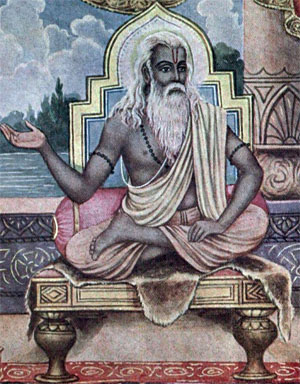
Vyasa
A painting of Vyasa sitting on a throne.
Personal
Born: Krishna Dvaipayana
Religion: Hinduism
Spouse: Vatikā[a]
Children: Shuka (son); Dhritarashtra, Pandu and Vidura (Niyoga sons)
Parents: Parashara (father); Satyavati (mother)
Notable work(s): Mahabharata; Bhagavata Gita
Known for Compilation of the four Vedas; Mahabharata
Religious career
Disciples: Shuka, Paila, Jaimini, Vaishampayana, Sumantu
Honours Festival of Guru Purnima, is dedicated to him, and also known as the Vyasa Purnima
Krishna Dvaipāyana, also known as Vyasa (/ˈvjɑːsə/; Sanskrit: व्यासः, romanized: Vyāsa, lit. 'Compiler') and Veda Vyāsa (वेदव्यासः, Veda-vyāsaḥ, "the one who classified the Vedas"), is a rishi (sage). He is best known as the traditional author of the Mahabharata, one of the two most important epics of India. He is also credited as the traditional compiler of the Vedas, as well as the writer of other important works including the Puranas.
As per the Mahabharata, Vyasa is the son of rishi Parashara and a fisherwoman named Kali (Satyavati), who later marries king Shantanu of Kuru. Throughout the epic, Vyasa appears occasionally helping the Kuru kingdom. His spiritual career includes compiling many texts and spreading the knowledge through his disciples.
The festival of Guru Purnima is dedicated to him. It is also known as Vyasa Purnima, the day believed to be both of his birth and when he divided the Vedas.[3][4] Vyasa is considered one of the seven Chiranjivis (long-lived, or immortals), who are still in existence according to Hindu tradition.
Spiritual life and disciples
Vyasa is believed to be an expansion of the God Vishnu, who came in Dvapara Yuga to make all the Vedic knowledge from oral tradition available in written form. According to the Mahabharata, he was the son of Satyavati, daughter of a fisherman chief and the wandering sage Parashara, who is credited with being the author of the first Purana, Vishnu Purana.[5] He was born on an island in the river Yamuna and was named Krishna Dvaipayana because of his dark complexion and birthplace.[6] It is believed that the name "Veda Vyasa" (lit "compiler of the Vedas") is a title rather than an actual name. Dvaipayana was given the title as he mastered the one combined Vedic scripture and divided it into four parts — Rigveda, Samaveda, Yajurveda and Atharvaveda.[7][8]
Vyasa had a son named name Shuka, who was his spiritual successor and heir.[ b] As per Skanda Purana, Vyasa married Vatikā, alias Pinjalā, who was the daughter of a sage named Jābāli. It is described that Vyasa's union with her produced his heir, who repeated everything that he heard, thus receiving the name Shuka (lit. Parrot).[1][2][9] Other texts including the Devi Bhagavata Purana also narrate the birth of Shuka but with drastic differences. Vyasa was desiring an heir, when an apsara (celestial damsel) named Ghritachi flew in front of him in form of a beautiful parrot, causing him sexual arousal. He discharges his semen, which fell on some sticks and a son developed. This time, he was named Shuka because of the role of the celestial parrot.[7] Shuka appears occasionally in the story as a spiritual guide to the young Kuru princes.
Besides his heir, Vyasa had four other disciples — Paila, Jaimini, Vaishampayana and Sumantu.[8] Each one of them was given the responsibility to spread one of the four Vedas. Paila was the made the incharge of Rigveda, Jaimini of the Samaveda, Vaishampayana of the Yajurveda and Sumantu of Atharvaveda.[10]
Vyasa is believed to have lived on the banks of Ganga in modern-day Uttarakhand. The site was also the ritual home of the sage Vashishta, along with the Pandavas, the five brothers of the Mahabharata.[11]
In the Mahabharata
Birth
During her youth, Satyavati was a fisherwoman who used to drive a boat. One day, she helped Parashara to cross the river Yamuna. He was enchanted by her beauty and wanted an heir from her. Initially, Satyavati did not agree, telling that if others would see them, then her purity would be questioned. Parashara created a secret place in bushes of a nearby island and a blanket of thick fog. She conceived and immediately gave birth to a son. Parashara named him Krishna Dvaipayana, referring to his dark complexion and birthplace.[12] Dvaipayana became an adult and promised his mother that he would come to her when needed. Parashara restored Satyavati's virginity, gifted her an enchanting smell and left with his son. Satyavati kept this incident a secret, not telling even King Shantanu whom she was married to later.[7]
Niyoga and birth of Vichitravirya's sons
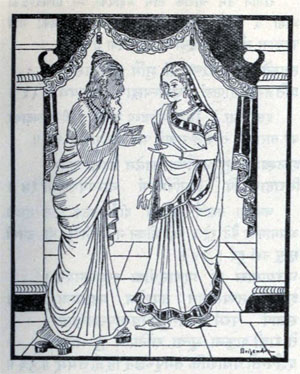
Vyasa with his mother (Satyavati)
Shantanu and Satyavati had two sons, named Chitrāngada and Vichitravirya. Both of them died early without leaving an heir, but Vichitravirya had two wives — Ambika and Ambalika. A widowed Satyavati initially asked her stepson, Bhishma, to marry both the queens, but he refused, citing his vow of celibacy. Satyavati revealed her secret past and requested him to bring her firstborn to impregnate the widows under a tradition called Niyoga.[13] By this time, Vyasa had compiled the Vedas.
Sage Vyasa was unkempt because of months of meditation in the forest. Hence upon seeing him, Ambika who was rather scared shut her eyes, resulting in their child, Dhritarashtra, being born blind. The other queen, Ambalika, turned pale upon meeting Vyasa, which resulted in their child, Pandu, being born pale. Alarmed, Satyavati requested that Vyasa meet Ambika again and grant her another son. Ambika instead sent her maid to meet Vyasa. The duty-bound maid was calm and composed; she had a healthy child who was later named Vidura.
Connection with the Pandavas and Kauravas
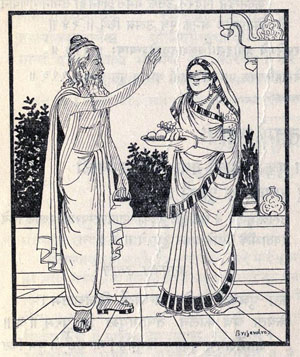
Gandhari serving Vyasa
When the children of 'Vichitravirya' grew up. Bhishma got them married to different women. Dhritarashtra was married to Gandhari, princess of Gandhara. Pandu married Kunti and Madri. Pandu left the kingdom, leaving Dhritarashtra as the acting king. Gandhari, during her adolescence, received a boon to have a hundred children but her pregnancy was taking a long period of time. After two years of pregnancy, Gandhari aborted her developing fetus, giving birth to a hard mass that looked like an iron ball. Vyasa came to the kingdom and using his knowledge, he asked to divide the mass into one hundred and one-pieces and put them into pots for incubation. After a year, 101 babies were born. Meanwhile, Kunti was blessed with two sons and later three more children were born upon Pandu's requests.
While everybody was rejoiced by the news of the birth of the Pandavas and Kauravas, misery took place in the forest. Pandu, who was cursed, died because of his attempt to make love with Madri. Kunti and the Pandavas returned to Hastinapur. Vyasa, feeling sorrow for his mother's fate, asked her to leave the kingdom and come with him to live a peaceful life. Satyavati, along with her two daughters-in-law, went to the forest.
The title "Vyasa"
Main article: Vyasa (title)
Hindus traditionally hold that Vyasa categorized the primordial single Veda into three canonical collections and that the fourth one, known as Atharvaveda, was recognized as Veda only very much later. Hence he was called Veda Vyasa, or "Splitter of the Vedas," the splitting being a feat that allowed people to understand the divine knowledge of the Veda. The word Vyasa means split, differentiate or describe.
The Vishnu Purana elaborates on the role of Vyasa in Hindu chronology.[14] The Hindu view of the universe is that of a cyclic phenomenon that comes into existence and dissolves repeatedly. Each kalpa cycle is presided over by a number of Manus, one for each manvantara, and each manvantara has a number of Yuga Cycles, each with four yuga ages of declining virtues. The Dvapara Yuga is the third yuga. The Vishnu Purana (Book 3, Ch 3) says:
In every third world age (Dvapara), Vishnu, in the person of Vyasa, in order to promote the good of mankind, divides the Veda, which is properly but one, into many portions. Observing the limited perseverance, energy and application of mortals, he makes the Veda fourfold, to adapt it to their capacities; and the bodily form which he assumes, in order to effect that classification, is known by the name of Veda-Vyasa. Of the different Vyasas in the present Manvantara and the branches which they have taught, you shall have an account. Twenty-eight times have the Vedas been arranged by the great Rishis in the Vaivasvata Manvantara... and consequently, eight and twenty Vyasa's have passed away; by whom, in the respective periods, the Veda has been divided into four. The first... distribution was made by Svayambhu (Brahma) himself; in the second, the arranger of the Veda (Vyasa) was Prajapati... (and so on up to twenty-eight).[15]
According to the Vishnu Purana, Guru Drona's son Aswatthama will become the next sage (Vyasa) and will divide the Veda in 29th Maha Yuga of 7th Manvantara.[16]
Works
The Mahabharata
Main article: Mahabharata
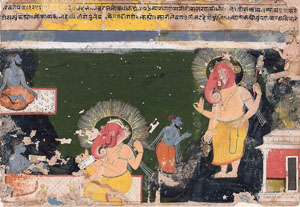
Ganesha writing the Mahabharat
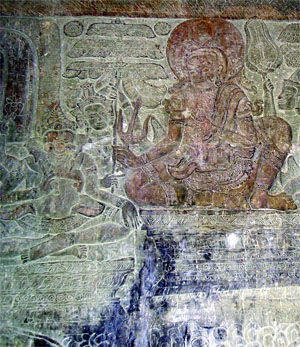
Vyasa narrating the Mahabharata to Ganesha, his scribe, Angkor Wat.
Vyasa is traditionally known as the chronicler of this epic and also features as an important character in Mahābhārata, Vyasa asks Ganesha to assist him in writing the text. Ganesha imposes a precondition that he would do so only if Vyasa would narrate the story without a pause. Vyasa set a counter-condition that Ganesha understands the verses first before transcribing them. Thus Vyasa narrated the entire Mahābhārata and all the Upanishads and the 18 Puranas, while Lord Ganesha wrote.
Vyasa's Jaya (literally, "victory"), the core of the Mahabharata, is a dialogue between Dhritarashtra (the Kuru king and the father of the Kauravas, who opposed the Pāndavas in the Kurukshetra War) and Sanjaya, his adviser and charioteer. Sanjaya narrates the particulars of the Kurukshetra War, fought in eighteen days, chronologically. Dhritarashtra at times asks questions and expresses doubts, sometimes lamenting, fearing the destruction the war would bring on his family, friends and kin.
Large and elaborate lists are given, describing hundreds of kingdoms, tribes, provinces, cities, towns, villages, rivers, mountains, forests, etc. of the (ancient) Indian subcontinent (Bhārata Varsha). Additionally, he gives descriptions of the military formations adopted by each side on each day, the death of individual heroes and the details of the war-races. Eighteen chapters of Vyasa's Jaya constitute the Bhagavad Gita, a sacred text in Hinduism. The Jaya deals with diverse subjects, such as geography, history, warfare, religion and morality.
The final version of Vyasa's work is the Mahābhārata. It is structured as a narration by Ugrasrava Sauti, a professional storyteller, to an assembly of rishis who, in the forest of Naimisha, had just attended the 12-year sacrifice known as Saunaka, also known as Kulapati.
Other texts attributed
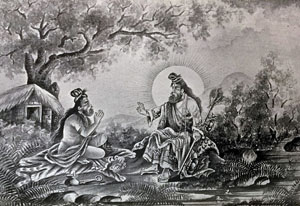
Narada meets Vyasa
Puranas
Main article: Puranas
Vyasa is also credited with the writing of the eighteen major Purāṇas, which are works of Indian literature that cover an encyclopedic range of topics covering various scriptures. His son Shuka narrates the Bhagavata Purana to Arjuna's grandson Parikshit.
Yoga Bhashya
The Yoga Bhashya, a commentary on the Yoga Sutras of Patanjali, is attributed to Vyasa.[17]
Brahma Sutras
Main article: Brahma Sutras
The Brahma Sutras are attributed to Badarayana — which makes him the proponent of the crest-jewel school of Hindu philosophy, i.e., Vedanta. Vaishnava Acharyas acknowledge that Badarayana is indeed Vyasa and he is known as Badarayana as he had his ashram in Badari kshetram. Others believe the name to be because the island on which Vyasa was born is said to have been covered with badara (Indian jujube/Ber/Ziziphus mauritiana) trees.[18] Some modern historians,[who?] though, suggest that these were two different personalities.
There may have been more than one Vyasa, or the name Vyasa may have been used at times to give credibility to a number of ancient texts.[19] Much ancient Indian literature was a result of long oral tradition with wide cultural significance rather than the result of a single author. However, Vyasa is credited with documenting, compiling, categorizing and writing commentaries on much of this literature.
In Sikhism
In Brahm Avtar, one of the compositions in Dasam Granth, the Second Scripture of Sikhs, Guru Gobind Singh mentions Rishi Vyas as an avatar of Brahma.[20] He is considered the fifth incarnation of Brahma. Guru Gobind Singh wrote a brief account of Rishi Vyas's compositions about great kings— Manu, Prithu, Bharath, Jujat, Ben, Mandata, Dilip, Raghu Raj and Aj[20][21]— and attributed to him the store of Vedic learning.[22]
Legacy
Vyasa is widely revered in Hindu traditions. A grand temple in honour of Sri Veda Vyasa has been built in Orai, Uttar Pradesh. The temple is known as Shri Bal Vyas Mandir. Shrimad Sudhindra Teerth Swamiji, the erstwhile spiritual guru of Sri Kashi Math Samsthan, Varanasi, had the vision to construct this temple in 1998. The temple is managed by the Chitrapur Sarasawath Brahmin (CSB) community who belongs to the said Sri Kashi Math Samsthan. This beautiful temple has now also become a popular tourist destination.
See also
• Hinduism portal
• Poetry portal
• Purana
• Parashara
• Guru Gita
• Gnana Saraswati Temple, Basar
• Vedic mythology
References
1. Dalal, Roshen (6 January 2019). The 108 Upanishads: An Introduction. Penguin Random House India Private Limited. ISBN 978-93-5305-377-2.
2. Pattanaik, Devdutt (1 September 2000). The Goddess in India: The Five Faces of the Eternal Feminine. Simon and Schuster. ISBN 978-1-59477-537-6.
3. Awakening Indians to India. Chinmaya Mission. 2008. p. 167. ISBN 978-81-7597-434-0.
4. What Is Hinduism?: Modern Adventures Into a Profound Global Faith. Himalayan Academy Publications. 2007. p. 230. ISBN 978-1-934145-00-5.
5. "Rishi Ved Vyas – Trikal Darshi Rajender Bhargav". Retrieved 14 September 2019.
6. Essays on the Mahābhārata, Arvind Sharma, Motilal Banarsidass Publisher, p. 205
7. Mani, Vettam (1975). Puranic Encyclopaedia: A Comprehensive Dictionary With Special Reference to the Epic and Puranic Literature. Delhi: Motilal Banarsidass. pp. 885 (Vyāsa). ISBN 0-8426-0822-2.
8. Sullivan, Bruce M. (1999). Seer of the Fifth Veda: Kr̥ṣṇa Dvaipāyana Vyāsa in the Mahābhārata. Motilal Banarsidass Publ. ISBN 978-81-208-1676-3.
9. Skanda Purāṇa, Nāgara Khanda, ch. 147
10. Shastri, J. L.; Tagare, Ganesh Vasudeo (1 January 2004). Ancient Indian Tradition and Mythology Volume 7: The Bhagavata-Purana Part 1. Motilal Banarsidass. ISBN 978-81-208-3874-1.
11. Strauss, Sarah (2002). "The Master's Narrative: Swami Sivananda and the Transnational Production of Yoga". Journal of Folklore Research. Indiana University Press. 23 (2/3): 221. JSTOR 3814692.
12. Monier-Williams, Sir Monier (1875). Indian Wisdom, Or, Examples of the Religious, Philosophical, and Ethical Doctrines of the Hindūs: With a Brief History of the Chief Departments of Sanskṛit Literature, and Some Account of the Past and Present Condition of India, Moral and Intellectual. Wm. H. Allen & Company.
13. Bhawalkar, Vanamala (2002). Eminent women in the Mahābhārata. Sharada.
14. Encyclopaedic Dictionary of Puranas, Volume 1 (2001), page 1408
15. "Vishnu Purana". Retrieved 15 March 2014.
16. Vishnu Purana -Drauni or Asvathama as Next Vyasa Retrieved 2015-03-22
17. Ian Whicher. The Integrity of the Yoga Darsana: A Reconsideration of Classical Yoga. SUNY Press. p. 320.
18. Gopal, Madan (1990). K.S. Gautam (ed.). India through the ages. Publication Division, Ministry of Information and Broadcasting, Government of India. p. 74.
19. The Yoga Sutras of Patanjali. Edwin F. Bryant 2009 page xl
20. Dasam Granth, Dr. SS Kapoor
21. Line 8, Brahma Avtar, Dasam Granth
22. Line 107, Vyas Avtar, Dasam Granth
Notes
1. Though the Mahabharata doesn't record Vyasa's wife, other text including the Skanda Purana refer sage Jabali's daughter Vatikā or Pinjalā as his wife[1][2]
2. Later, Vyasa became the surrogate father of Kuru princes — Pandu and Dhritrashtra
Sources
• The Mahabharata of Krishna-Dwaipayana Vyasa, translated by Kisari Mohan Ganguli, published between 1883 and 1896
• The Arthashastra, translated by Shamasastry, 1915
• The Vishnu-Purana, translated by H. H. Wilson, 1840
• The Bhagavata-Purana, translated by A. C. Bhaktivedanta Swami Prabhupada, 1988 copyright Bhaktivedanta Book Trust
• The Jataka or Stories of the Buddha's Former Births, edited by E. B. Cowell, 1895
External links
• Quotations related to Vyasa at Wikiquote
• Media related to Vyasa at Wikimedia Commons
• Works written by or about Vyasa at Wikisource
• The Mahābhārata – Ganguli translation, full text at sacred-texts.com
**************************
Parasara
by Wikipedia
Accessed: 1/28/23
Parāśara was a maharshi and the author of many ancient Indian texts. He is accredited as the author of the first Purana, the Vishnu Purana, before his son Vyasa wrote it in its present form. He was the grandson of Vasishtha, the son of Śakti Maharṣi. There are several texts which give reference to Parāśara as an author/speaker. The various texts attributed to him are given in reference to Parāśara being the speaker to his student.[4]
Etymology
When Parāśara's father, Sakti Maharishi died after being devoured by the king Kalmashapada along with Vashistha's other sons, Vashistha resorted to ending his life by suicide. Hence he jumped from Mount Meru but landed on soft cotton, he entered a forest fire only to remain unharmed, then he jumped into the ocean who saved him by casting him ashore. Then he jumped in the overflowing river Vipasa, which also left him ashore. Then he jumped into the river Haimavat, which fled in several directions from his fear and was named Satadru. Then when he returned to his asylum, he saw his daughter-in-law pregnant. When a son was born he acted as his father and hence forgot completely about destroying his life. Hence, the child was named Parāśara which meant enlivener of the dead.[5]
Genealogy
According to the Vedas, Brahma created Vasishtha (reborn to Mitra-Varuna), who, with his wife Arundhati, had a son named Śakti Mahariṣhi who sired Parāśara. With Satyavati of Kaivartta clan[6] Parāśara is father of Vyasa. Vyāsa sired Dhritarashtra and Pandu through his deceased step brother's wives, Ambika and Ambalika and Vidura through a hand-maiden of Ambika and Ambalika. Vyāsa also sired Shuka through his wife, Jābāli's daughter Pinjalā. Thus Parāśara was the biological great-grandfather of both the warring parties of the Mahābhārata, the Kauravas and the Pandavas.[citation needed]
Legends
There is a story of Rishi Parāśara: Śakti Maharṣi died in his early age. This made Vasishtha, his father live in his hermitage with Adrushyanti (wife of Shakti Maharishi). Vasistha heard the chanting of the Vedas and Adrushyanti told him that Vedic hymn sounds were coming from the child of his son, Sakti, that was developing in her womb. Vasistha was happy to hear this. Adrushyanti gave birth to a son and the child grew up to become Parāśara.[7]
Parāśara was raised by his grandfather Vasishtha because he lost his father at an early age. His father, Śakti Muni, was on a journey and came across an angry rākṣasa (demon) who had once been a king but was turned into a demon feeding on human flesh as a curse from Vasishtha. The demon devoured Parāśara's father. In the Vishnu Purana, Parāśara speaks about his anger from this:[8]
I had heard that my father had been devoured by a Rākṣasa employed by Vishwamitra: violent anger seized me and I commenced a sacrifice for the destruction of the Rākṣasas: hundreds of them were reduced to ashes by the rite, when, as they were about to be entirely exterminated, my grandfather Vasishtha said to me: Enough, my child; let thy wrath be appeased: the Rākṣasas are not culpable: thy father's death was the work of destiny. Anger is the passion of fools; it becometh not a wise man. By whom, it may be asked, is anyone killed? Every man reaps the consequences of his own acts. Anger, my son, is the destruction of all that man obtains by arduous exertions, of fame, and of devout austerities; and prevents the attainment of heaven or of emancipation. The chief sages always shun wrath: be not subject to its influence, my child. Let no more of these unoffending spirits of darkness be consumed. Mercy is the might of the righteous.[citation needed]
Parāśara Muni (Sage) once halted for a night in a little hamlet on the banks of the river Yamuna. He was put up in the house of the fisherman-chieftain Dasharaj. When dawn broke, the chief asked his daughter, Matsyagandha, whose name means "one with the smell of fish", to ferry the sage to his next destination. When in the ferry, Parāśara was attracted by the beautiful girl and asked her to fulfill his desire of giving a son to her. Matsyagandha refused fearing the other people and sages who were standing on the bank of river at the other side.[1]
He then created an island within the river by his mystic potency and asked her to land the boat there. On reaching the other side, the sage once again chanted the mantra to make her pregnant, but she declared that her body stank and Parāśara granted her the boon that the finest fragrance may emit from her person. She was thereafter known as Satyavati (pure fragrance).[1] Matsyagandha was transformed (by the powers of the sage) into Yojanagandha ("she whose fragrance can be smelled from across a yojana").[9] She now smelled of musk, and so was called Kasturi-Gandhi ("musk-fragrant").[1] Then, she insisted that the act of getting a child was not appropriate in broad daylight, as her father and others would see them from the other bank; they should wait till night. The sage, with his powers, shrouded the entire area in fog. Before Parāśara gave her a child, Satyavati again interrupted him to say that he would enjoy his child and depart, leaving her shamed in society. She asked Parāśara to promise her that the childbirth would be a secret and her secret intact; the son born from their union would be as famous as the great sage, and her fragrance and youth would be eternal. Parāśara granted her these wishes and was satiated by the beautiful Satyavati. Parāśara then gave her a child who was a son called Krishna Dvaipāyana was born, who was dark-complexioned and hence may be called by the name Krishna (black) and also the name Dwaipayana, meaning 'island-born'. He later compiled the classic Vedic literatures of India, and so is called Vyasa who is the 17th incarnations of Lord Vishnu. Leaving Satyavati, Parāśara proceeded to perform Tapas (intense meditation). Later Vyasa also became a Rishi and Satyavati returned to her father's house and in due course, married Śantanu.[1]
In Anushasana Parva of Mahabharata, Parāśara told Yudhisthira that he prayed to Shiva. His desire was to obtain a son with great ascetic merit, endued with superior energy, earn world-wide fame, and arrange the Vedas. Shiva appeared and granted him his wishes and in addition, he told him that his son Krishna will be one of the Saptarshis of Savarni manvantara, be immortal by being freed of diseases, and he will be friend of Indra.[10]
Parāśara was known as the "limping sage". He had his leg wounded during an attack on his āśrama. When a ṛṣi dies he merges back into an element or an archetype. When Sage Parāśara was walking through a dense forest he and his students were attacked by wolves. He was unable to get away in his old age with a lame leg and he left this world merging into the wolves.[11]
The Monument of Parāśara Muni is available at Junha - Panhala fort in Tal Kavathe Mahankal Sangli district of Maharashtra. A cave supposed to be of Parāśāra Muni is present at the fort.
Ṛgveda
In the Ṛgveda, Parāśara, son of Śakti Muni (Parāśara Śāktya), is the seer of verses 1.65-73 which are all in praise of Agni (the sacred fire), and part of 9.97 (v.31-44) which is in praise of Soma. Below is 1.73.2
devo na yaḥ savitā satyamanmā kratvā nipāti vṛjanāni viṣvā
purupraṣasto amatirna satya ātmeva Sevo didhiṣāyyo bhūt
He who is like the divine Sun, who knows the truth (of all things), preserves by his actions (his votaries) in all encounters; like nature, he is unchangeable and, like soul, is the source of all happiness: he is ever to be cherished.[12]
Texts attributed to Parāśara
• Seer of verses in the Ṛgveda: recorded as the seer of RV 1.65-73 and part of RV 9.97.
• Parāśara Smṛti (also called Parāśara Dharma Saṃhitā): a code of laws which is stated in the text (1.24) to be for Kali Yuga.[13]
• Speaker of Viṣṇu Purana to Maitreya.[14]
• Speaker of the Bṛhat Parāśara Horāśāstra, abbreviated as BPHS. It is considered a foundational text of Hindu astrology.
• Speaker of the Vṛkṣāyurveda ("the science of life of trees"), one of the earliest texts on botany.[15] This text was considered to be an ancient botany primer for students of Traditional Indian Medicine.
• Krishi Parāśaram, a book that dealt with agriculture and weeds.[citation needed]
Notes
1. Mani, Vettam (1975). Puranic Encyclopaedia: A Comprehensive Dictionary With Special Reference to the Epic and Puranic Literature. Delhi: Motilal Banarsidass. pp. 885 (Vyāsa). ISBN 0-8426-0822-2.
2. Dalal, Roshen (18 April 2014). Hinduism: An Alphabetical Guide. ISBN 9788184752779.
3. Bhiḍe, Śrīpāda Raghunātha (1996). Wife of Sakti Maharsi. ISBN 9788185080987.
4. "Rishi Parashara - Speaking Tree".
5. Pratap Chandra Roy's Mahabharata Adi Parva Pages: 406-410
6. Sen, Kshitimohan (1997). Jatived (in Bengali). Shantiniketan: Visva-Bharati University. pp. 46, 49.
7. "Puranic encyclopaedia: comprehensive dictionary with special reference to the epic and Puranic literature". archive.org. 1975.
8. Wilson, H. H. The Vishnu Purana: A System of Hindu Mythology and Tradition.
9. Bhattacharya, Pradip (May–June 2004). "Of Kunti and Satyawati: Sexually Assertive Women of the Mahabharata" (PDF). Manushi (142): 21–25.
10. "The Mahabharata, Book 13: Anusasana Parva: Anusasanika Parva: Section XVIII". http://www.sacred-texts.com. Retrieved 13 November 2022.
11. Munshi, K. M. The Book of VedaVyaasa: The Master.
12. Rgveda 1.73.2 Translation by H.H.Wilson
13. https://archive.org/download/ParasharaS ... thiPdf.pdf[bare URL PDF]
14. Flood, Gavin. An Introduction to Hinduism.
15. Ancient Indian Botany and Taxonomy
References
• Flood, Gavin (1996). An Introduction to Hinduism. Cambridge: Cambridge University Press. ISBN 0-521-43878-0.
• Ganguli, Kisari Mohan. "The Mahabharata of Krishna-Dwaipayana Vyasa" published between 1883 and 1896, http://www.sacred-texts.com/hin/m12/m12c049.htm
• Monier-Williams, Sanskrit Dictionary (1899).
• Munshi, K.M. "The Book of VedaVyaasa: The Master". Bharatiya Vidya Bhavan, Bombay, 1971.
• Wilson, H. H. (2006). The Vishnu Purana: A System of Hindu Mythology and Tradition. Cambridge: Read Country Books. ISBN 1-84664-664-2.
• Translation and commentary Brihat Parāśara Hora Sastra
• Translation to Portuguese Brihat Parāśara Hora Shastra

